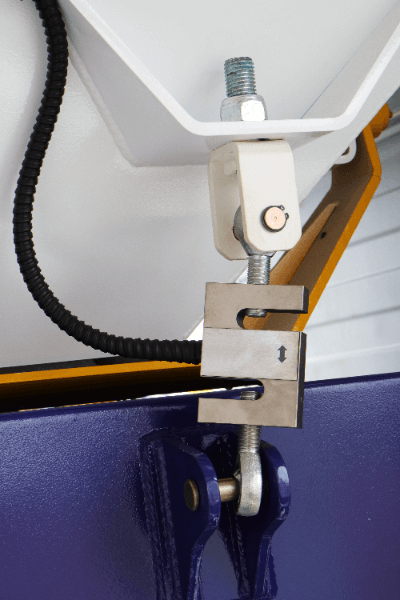What Is a Load Cell?
 A load cell is a load transducer, a sensor that detects a load or force, converts it into an electrical signal, and outputs it. The output corresponding to the load or force is used to display or record the load, and may also be used for control.
A load cell is a load transducer, a sensor that detects a load or force, converts it into an electrical signal, and outputs it. The output corresponding to the load or force is used to display or record the load, and may also be used for control.
In addition to the strain gauge type, which measures the deformation strain of an object, other types of load or force detection methods include the piezo piezoelectric type, metal thin film type, capacitance type, optical fiber type, vibration type, and magnetostrictive type.
The output of load cell is an analog or digital signal of voltage or current corresponding to the load. They are used to display and record the load on scales, measure loading capacity, and measure the load on material testing machines, and are also used to control plants.
Uses of Load Cells
Load cells are used in electronic scales, testing machines, flow meters, industrial scales, and various measuring instruments. For example, products for household use include scales, digital scales, and toilet seats for shower toilets.
In industrial applications, in addition to scales for heavy objects, they are often used in tensile testing machines, viscoelasticity measuring devices, presses, and yarn and film winding devices. They are also used to test the propulsion of jet engines, monitor the tension of mooring ropes on ships, measure torque in engines, monitor axle loads, measure wire tension in elevators, and weigh hoppers and silos.
Load cells are also used on the control rods of some aircraft. When the pilot applies force to the control stick, the computer detects the magnitude of the load and controls the airplane.
In industry, load cells are indispensable devices to measure the weight of products for quality improvement, productivity enhancement, and cost reduction, and to digitize the data for monitor display, good/fail judgment, printing, and data storage.
Principle of Load Cells
There are four main types of load cells: beam type, column type, S-shape type, and diaphragm type, depending on the shape of the member that is deformed when subjected to a load.
1. Beam Type
Beam type load cells measure the amount of beam deformation that occurs when a load is applied to the tip of a cantilever beam. It is used for platform scales.
2. Column Type
The column type measures the deformation strain in the compressive direction on the surface of a cylinder by applying a load to the cylindrical member. It is used for industrial applications such as tanks and hoppers. Multiple load cells are often used, in which case the load must be applied equally to each cell.
3. S-Shape
In the S-shape, a load is applied to both ends of an S-shaped member, and the deformation of the S-shaped member is measured and converted into a load. It is often used in tensile testing machines to measure tensile force.
4.Diaphragm Type
Diaphragm type load cells apply a load to the center of a diaphragm and measure the amount of deformation of the diaphragm. This type is generally used for load cells.
By changing the size and material of the cell member used, the scale of the load to be measured can be made larger or smaller. This makes it possible to measure loads over a wide range, from a few grams to huge forces in the ton range. In the measurement of minute loads, high-precision load cells capable of measuring on the order of mN have been developed and are used in the research and development of artificial muscles.
Methods for detecting the amount of deformation of materials that deform under load include strain gage, piezo piezoelectric, thin metal film, capacitance, optical fiber, vibration, and magnetostrictive methods.
In particular, the strain gage type is often used. A strain gage is attached to an elastic body called a strain generator, which expands or contracts due to minute deformation, resulting in a change in cross-sectional area, which in turn changes the resistance of the gage. Since this change is proportional to the load, the load applied to the strain gage is calculated from the change in resistance.
Other Information on Load Cells
1. Units of Load Cells
A load cell displays the measured value in SI unit of “force” “N” newton. Depending on the capacity of the Load Cell, “mN” or “kN” may be used.
“N” Newton is the value obtained by multiplying the mass by the acceleration of gravity. If the gravitational acceleration at the measurement location is known, the load cell can measure the mass (㎏).
2. Accuracy of Load Cells
Generally, “accuracy” is not mentioned in the specifications of a load cell. The accuracy of a load cell is judged comprehensively based on the linearity, hysteresis, repeatability, and temperature effects described in the specifications.
When a predetermined voltage is applied to a load cell, it outputs a voltage proportional to the load, but this voltage is tiny, about 20mV at most. Since this small voltage is further divided into parts per million and measured, the measuring instrument used must be highly stable and accurate.
The accuracy of a measuring device using load cells must be judged comprehensively, including errors caused by individual load cells and indicators, temperature conditions, installation conditions, vibration, and other factors. To do so, the accuracy of the load cell, which is the detection part, and the accuracy of the indicator, are determined respectively, and the overall accuracy is calculated by the square root of the sum of their squares.